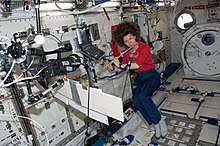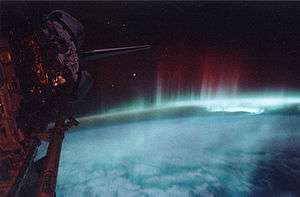Music in space
Music in space is music played in or broadcast from a spacecraft in outer space.[1] The first ever song that was performed in space was a Ukrainian song “I look up at the sky” (“Дивлюсь я на небо”) sang on 12 August 1962 by Pavlo Popovych, cosmonaut from Ukraine at a special request of Serhiy Korolyov, rocket engineer and spacecraft designer from Ukraine. According to the Smithsonian Institution, the first musical instruments played in outer space were an 8-note Hohner "Little Lady" harmonica and a handful of small bells carried by American astronauts Wally Schirra and Thomas P. Stafford aboard Gemini 6A.[2] Upon achieving a space rendezvous in Earth orbit with their sister ship Gemini 7 in December 1965, Schirra and Stafford played a rendition of "Jingle Bells" over the radio after jokingly claiming to have seen an unidentified flying object piloted by Santa Claus. The instruments had been smuggled on-board without NASA's knowledge, leading Mission Control director Elliot See to exclaim "You're too much" to Schirra after the song.[2] The harmonica was donated to the Smithsonian by Schirra in 1967, with his note that it "...plays quite well".[3]

In the 1970s music tape cassettes were brought to the American space station Skylab,[4] while Soviet cosmonauts Aleksandr Laveikin and Yuri Romanenko brought a guitar to the space station Mir in 1987.[1] Musical instruments must be checked for gases they may emit before being taken aboard the confined environment of a space station.[5] As of 2003, instruments that have been aboard the International Space Station include a flute, a keyboard guitar, a saxophone, and a didgeridoo.[5]
Music in space has been a focal point of public relation events of various human spaceflight programs.[1] NASA astronaut Carl Walz played a rendition of the Elvis Presley song "Heartbreak Hotel" aboard the ISS in 2003 which was also recorded and transmitted to Earth.[5] Canadian Space Agency astronaut Chris Hadfield, commander of Expedition 35 to the International Space Station, recorded a music video of the song "Space Oddity" by David Bowie aboard the space station. The first music video ever shot in space,[6] the video went viral and received widespread international media coverage after being posted to YouTube.[7] Bowie himself later called the cover "possibly the most poignant version of the song ever created".[8]
Dongfanghong I
Dongfanghong I (simplified Chinese: 东方红一号; traditional Chinese: 東方紅一號; pinyin: Dōngfānghóng Yīhào; lit.: 'The East is Red 1') was the People's Republic of China's first space satellite, launched successfully on 24 April 1970 as part of the PRC's Dongfanghong space satellite program. The satellite carried a radio transmitter which broadcast the song of the same name, Dōngfānghóng or "The East Is Red"; the broadcast lasted for 20 days while in orbit.
Apollo 17
A few bars of "The Fountain in the Park" were sung on the Moon by NASA Astronauts Harrison Schmitt and Eugene Cernan on the 1972 Apollo 17 mission. Schmitt started by singing "I was strolling on the Moon one day..." when Cernan joined in. Cernan kept with the original "merry month of May", however, while Schmitt sang "December", which was the actual date at the time. After a brief debate, Schmitt resumed, singing "When much to my surprise, a pair of bonny eyes..." until he could no longer remember the lyrics and began vocalizing the notes instead.[9] Moments later, Capsule Communicator Robert A. Parker cut in from Houston, saying "sorry about that, guys, but today may be December."
Voyager Golden Record

The Voyager program probes Voyager 1 and Voyager 2 were launched by NASA with a message aboard — a kind of time capsule, intended to communicate a story of the world of humans on Earth.[10]
This is a present from a small, distant world, a token of our sounds, our science, our images, our music, our thoughts and our feelings. We are attempting to survive our time so we may live into yours.
The records feature spoken greetings in fifty-nine languages,[11][12] "sounds of Earth",[13] and a 90-minute selection of music from many cultures, including Eastern and Western classics.[14]
Pink Floyd
On 21 November 1988, a cassette tape of Pink Floyd's live Delicate Sound of Thunder album (minus the cassette box, for weight reasons) was taken into space by the crew of the Soviet Soyuz TM-7 mission.[15] The launch, at Baikonur Cosmodrome, was attended by the band's David Gilmour and Nick Mason, who made an audio recording of the event for potential use in a future project.[15] This was claimed by Gilmour to have been the first rock music recording in space.[15] The tape was left on the Mir space station when the mission crew returned to Earth.[15]
Beagle 2 and Blur
In 2003 the British space organization's Beagle 2 probe was scheduled to play a song from the UK music band Blur, upon touchdown on the planet Mars.[16] It was not known what happened to Beagle 2 for 11 years after landing, and it was considered lost. When it was found intact in 2015, however, the possibility was raised that Beagle 2 had successfully played the song on Christmas Day in 2003 upon landing, but failed to transmit back to Earth.[17]
Curiosity rover and Reach for the Stars
American recording artist will.i.am wrote, produced, and recorded the song "Reach for the Stars"[18] (and their instrumental-driven version subtitled "Mars Edition" and "NASA Edition"[19]) in commemoration of the landing of the Curiosity rover on Mars. The song was first released on August 28, 2012, and it became the first song that was successfully broadcast from another planet.[20]
Elon Musk's Tesla Roadster
.jpg)
Elon Musk's Tesla Roadster was launched into Earth orbit, then Solar orbit, in February 2018 as part of the Falcon Heavy Test Flight. The sound system on board the car was looping David Bowie's songs "Space Oddity" and "Life on Mars?".[21]
Project DaVinci CubeSat
As a part of NASA's ElaNa 19 intiative, 18 year-old millionaire Erik Finman collaborated with a team of high school students from Coeur d'Alene, Idaho, and designed a CubeSat named Project DaVinci.[22][23] The CubeSat serves as a time capsule orbiting around the Earth, and contains a collection of videos, music and movies, including the Taylor Swift album, 1989. The album was uploaded to the satellite, while its Swift-autographed CD was engraved to the satellite's side.[24][25] DaVinci was launched into space on December 16, 2018, from Mahia, New Zealand.[26]
References
- "Tuned in: music of the Soviet space programme". sciencemuseum.org.uk. Retrieved November 4, 2016.
- Edwards, Owen (2005). "The Day Two Astronauts Said They Saw a UFO Wearing a Red Suit". Smithsonian Magazine. The Smithsonian Institution. Retrieved June 23, 2017.
- "Harmonica, Gemini 6". 20 March 2016.
- "Archived copy". Archived from the original on 2016-12-14. Retrieved 2016-11-13.CS1 maint: archived copy as title (link)
- "Space Station Music". NASA Science News. NASA. September 4, 2003. Archived from the original on October 26, 2011.
- Davis, Lauren (12 May 2013). "Chris Hadfield sings "Space Oddity" in the first music video in space". Gawker Media. Retrieved 29 May 2013.
- Knapp, Alex (13 May 2013). "Astronaut Chris Hadfield Sings David Bowie As He Departs The International Space Station". Forbes. Retrieved 29 May 2013.
- Andrew Griffin. "David Bowie: How Chris Hadfield's 'Space Oddity' cover from orbit was helped by the 'Starman'". The Independent. Retrieved 2016-10-02.
- Astronauts Strolling on Moon and Singing (Videotape). NASA. December 1972. Archived from the original on 2016-12-21. Retrieved 2018-05-02.
- "Voyager – Golden Record". NASAaccessdate= September 23, 2010.
- Sagan, Carl (1994). Pale Blue Dot: A Vision of the Human Future in Space (1st ed.). New York: Random House. ISBN 9780679438410.
- "Traveller's Tales [Carl Sagan Tribute Series, S01E16]". Retrieved February 10, 2012.
- "Voyager – Spacecraft – Golden Record – Sounds of Earth". NASA. Retrieved August 17, 2008.
- ozmarecords. "Voyager". ozmarecords. Retrieved 2018-04-12.
- Miles, Barry; Andy Mabbett (1994). Pink Floyd the visual documentary. London: Omnibus Press. ISBN 0711941092.
- "Listen to the music that the Beagle 2 probably played on Mars in 2003 - The Verge". theverge.com. Retrieved November 4, 2016.
- Vincent, James (16 January 2015). "Listen to the music that the Beagle 2 probably played on Mars in 2003".
- Reach For the Stars by will.i.am, retrieved 2019-11-30
- Reach for the Stars (Mars Edition) - Single by will.i.am, retrieved 2019-11-30
- Karimi, Faith (August 29, 2012). "Will.i.am premieres song -- from Mars". CNN. Retrieved January 25, 2014.
- "SpaceX Successfully Launches the Falcon Heavy—And Elon Musk's Roadster". WIRED. Retrieved 7 February 2018.
- Buhr, Sarah (August 17, 2017). "Teen bitcoin millionaire Erik Finman is launching Taylor Swift's '1989' into space". TechCrunch. Retrieved 2020-07-05.
- Heiney, Anna (December 10, 2018). "ELaNa 19: DaVinci". NASA. Retrieved July 5, 2020.
- Hooper, Ben (December 14, 2016). "Idaho teen team's space-bound time capsule includes Taylor Swift album". UPI. Retrieved 2020-07-05.
- Weinberger, Matt (August 17, 2017). "This teenage Bitcoin millionaire high school dropout is sending a signed Taylor Swift CD into space". Business Insider. Retrieved July 5, 2020.
- Mahoney, Erin. "Past ElaNa CubeSat Launches". NASA. Retrieved July 5, 2020.
